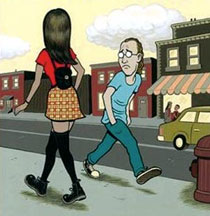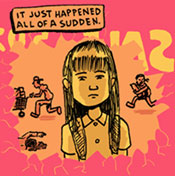 Joe Matt was one of ‘The Toronto Three’ in the 90’s; he was a no-holds barred autobiographical cartoonist who, with his friends Chester Brown and Seth, ushered in the first wave of Drawn and Quarterly work. Matt drew attention for his sense of humor as well as exposing the depraved corners of his life, including porn addiction, excessive cheapness, and an increasingly destructive relationship with his girlfriend Trish. Kumar and Koom discuss The Poor Bastard and reflect about encountering Matt’s work, the interaction between real life and representation, and the connection between humor and depravity.
Joe Matt was one of ‘The Toronto Three’ in the 90’s; he was a no-holds barred autobiographical cartoonist who, with his friends Chester Brown and Seth, ushered in the first wave of Drawn and Quarterly work. Matt drew attention for his sense of humor as well as exposing the depraved corners of his life, including porn addiction, excessive cheapness, and an increasingly destructive relationship with his girlfriend Trish. Kumar and Koom discuss The Poor Bastard and reflect about encountering Matt’s work, the interaction between real life and representation, and the connection between humor and depravity.
LINK: Did the woman Frankie was modeled after demand to be left out of Joe’s comic?
Podcast: Play in new window | Download

 This week, an interview with Frank Santoro, who
This week, an interview with Frank Santoro, who  How would you feel if someone you went to high school with showed up on the news as a murderer? That’s what happened to the cartoonist Derf Backderf, who was acquainted with future serial killer Jeffrey Dahmer when they were teenagers in the ’70s.
How would you feel if someone you went to high school with showed up on the news as a murderer? That’s what happened to the cartoonist Derf Backderf, who was acquainted with future serial killer Jeffrey Dahmer when they were teenagers in the ’70s. Anthropomorphized cats in a Pulp Fiction-style shootout; a tiny man found sleeping in the grass; two people hiding in an abandoned restaurant during some catastrophic event. These were some of the one-page, where’s-the-rest-of-it scenes in Ian M‘s
Anthropomorphized cats in a Pulp Fiction-style shootout; a tiny man found sleeping in the grass; two people hiding in an abandoned restaurant during some catastrophic event. These were some of the one-page, where’s-the-rest-of-it scenes in Ian M‘s